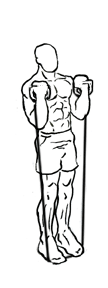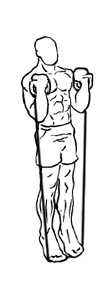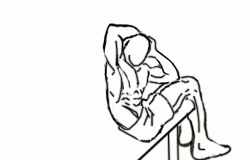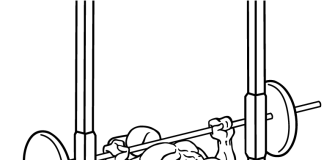Last Updated on September 30, 2022
If you’re looking for a simple yet effective exercise to strengthen your calves, Calf Raises with Band might just be what you need. This exercise uses a resistance band to target your calf muscles, helping build strength, endurance, and stability. Whether you’re an athlete looking to enhance performance or someone who simply wants to improve leg strength and stability, calf raises can work wonders.
In this comprehensive guide, we’ll dive into everything you need to know about calf raises with a resistance band. From the benefits to how you can do them correctly, and tips for getting the most out of this exercise, this post will set you on the right track to stronger calves.
Why Calf Raises with a Band?
Calf raises are one of the most fundamental exercises for the lower leg, particularly the gastrocnemius and soleus muscles. Adding a resistance band increases the intensity of the exercise, giving you a more targeted workout that focuses on strength and muscle endurance. The use of bands is a great way to engage your muscles in a controlled manner, making it suitable for beginners and experienced fitness enthusiasts alike.
Here’s why calf raises with a band are so effective:
- Resistance-based training: The resistance band provides constant tension throughout the movement, creating more challenge for the calves than bodyweight alone.
- Improved stability: Balancing while using a resistance band engages stabilizing muscles in your feet and ankles, improving coordination and stability.
- Accessibility: Bands are portable and inexpensive, making this a convenient exercise to do anywhere, from home to the gym or even while traveling.
- Muscle isolation: Using a resistance band helps focus more on your calf muscles, leading to better activation and muscle development over time.
Step-by-Step: How to Perform Calf Raises with a Band
Let’s break down how to perform calf raises with a resistance band correctly. Proper form is key to avoiding injury and maximizing results.
- Position the Band
- Start by standing tall with your feet hip-width apart.
- Place an exercise resistance band under the balls of your feet. You’ll want to ensure the band is secure and won’t slip when you begin the exercise.
- Hold the handles of the band and bring them up towards your shoulders. The band should be tight enough to create resistance but not so tight that it restricts your movement.
- Engage Your Core
- Before you start the movement, engage your core by pulling your belly button towards your spine. This will help with balance and ensure you’re using your muscles effectively.
- Keep your chest lifted and shoulders back to maintain proper posture throughout the exercise.
- Raise Onto Your Toes
- Slowly raise up onto your toes, pushing through the balls of your feet. As you lift, you should feel your calf muscles working to elevate your body.
- Keep your hands steady by your shoulders, maintaining tension in the band.
- Pause at the Top
- Once you’ve reached the top of the movement, hold this position for a second or two. This pause will create a brief isometric hold, engaging the calf muscles even more intensely.
- Lower Your Heels
- Slowly and with control, lower your heels back to the floor. Avoid simply dropping down; instead, focus on feeling the stretch in your calves as your heels descend.
- The lowering phase is just as important as the lift, so maintain control to maximize the benefits.
- Repeat
- Continue the movement for the desired number of repetitions. Aim for 12-15 reps per set for muscle endurance, or 8-10 reps for strength building.
Tips for Maximizing Your Calf Raises
To get the most out of your calf raises with a resistance band, keep these tips in mind:
- Use the right band tension: If you’re just starting out, use a lighter resistance band to get a feel for the movement. As your strength improves, gradually increase the resistance to challenge your muscles further.
- Focus on form: It’s better to do fewer reps with proper form than more reps with sloppy technique. Avoid rushing through the exercise; take your time and focus on controlled movements.
- Incorporate variations: Add variety to your routine by incorporating different types of calf raises. For example, try doing the exercise one leg at a time to improve balance and stability.
- Mind your range of motion: Make sure you’re achieving full range of motion during the exercise. This means lifting as high as you can onto your toes and lowering your heels fully to the ground.
- Increase intensity gradually: Don’t jump straight to a high-resistance band. Increase intensity gradually to avoid injury and allow your muscles to adapt.
Calf Anatomy: The Muscles You’re Working
To understand the full benefits of calf raises with a band, it’s important to know what muscles are involved. This exercise primarily targets the two major muscles of your calves:
- Gastrocnemius: This is the larger, visible muscle on the back of your lower leg. It’s responsible for the bulging shape of your calves and plays a key role in plantar flexion (pointing your toes).
- Soleus: This muscle lies underneath the gastrocnemius and is responsible for endurance-based activities such as standing and walking. While it doesn’t contribute as much to calf size, it’s critical for muscle stamina and stability.
Together, these muscles work to stabilize your ankles, support your body weight, and enable movements like walking, running, and jumping.
Benefits of Calf Raises with Band
Aside from calf muscle growth and strengthening, calf raises with a resistance band offer several other benefits:
- Improved athletic performance: Strong calves can improve your running speed, jumping height, and overall lower body power. Whether you’re into sports like basketball or just enjoy running, strong calves can help you perform better and reduce injury risk.
- Enhanced balance and coordination: By engaging stabilizing muscles in your lower legs, this exercise helps improve your balance and coordination, which is crucial for daily activities and athletic movements.
- Reduced risk of injury: Strengthening your calves helps protect your ankles and knees from injuries, especially during high-impact activities. Calf raises build resilience in the lower leg muscles and tendons, lowering the chance of strains and sprains.
- Aesthetic benefits: If you’re looking to develop more defined calves, calf raises with a resistance band can help create that toned and sculpted appearance over time.
Incorporating Calf Raises into Your Routine
Calf raises with a band can be incorporated into almost any fitness routine. Here are a few ideas to help you add them to your workouts:
- As a Warm-up: Do a few sets of calf raises before your lower body workouts to activate your calf muscles and prepare them for more intense exercises like squats or lunges.
- Part of Leg Day: Add calf raises to your leg day routine, targeting your calves after your main exercises like squats or deadlifts.
- Daily Movement: Calf raises can be done daily to promote circulation and relieve muscle tension. They’re especially useful if you spend a lot of time sitting or standing throughout the day.
Common Mistakes to Avoid
Even though calf raises are a simple exercise, there are common mistakes that people make that can limit results or even lead to injury. Here are a few to watch out for:
- Not using full range of motion: One of the biggest mistakes is not fully extending onto your toes or lowering your heels back down. Make sure you’re getting the full stretch and contraction in your calf muscles.
- Leaning forward or backward: To maintain proper form, keep your body upright and avoid leaning in any direction. Engaging your core will help with this.
- Using momentum: It can be tempting to rush through the reps, especially as your calves get tired. However, this reduces the effectiveness of the exercise. Focus on slow, controlled movements to really work the muscles.
- Skipping the pause: Holding the top position for a second or two adds an isometric element to the exercise, increasing muscle engagement. Don’t skip this part – it’s key for building strength.
Final Thoughts
Calf raises with a resistance band are an excellent exercise to strengthen your lower legs, improve stability, and enhance overall athletic performance. They’re simple, effective, and can be done virtually anywhere, making them a must-have in any fitness routine. Whether you’re aiming for stronger calves, better balance, or more endurance, this exercise can help you reach your goals.
Be sure to focus on proper form, take your time with each rep, and gradually increase the resistance as your calves get stronger. With consistency, you’ll start to notice improvements in both your calf strength and the way your legs look and feel.
So, grab your resistance band and start incorporating calf raises into your workout routine today!


Exercise images by Everkinetic.






